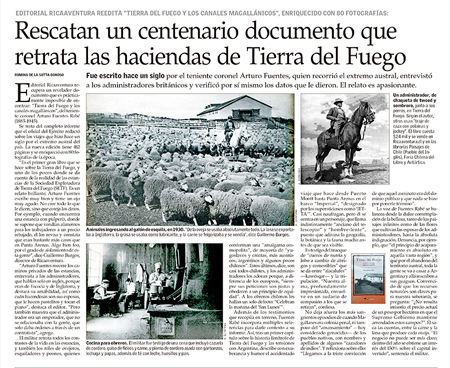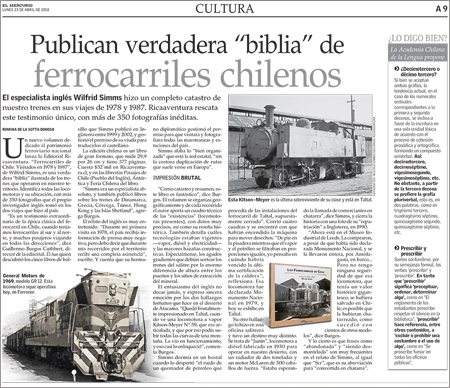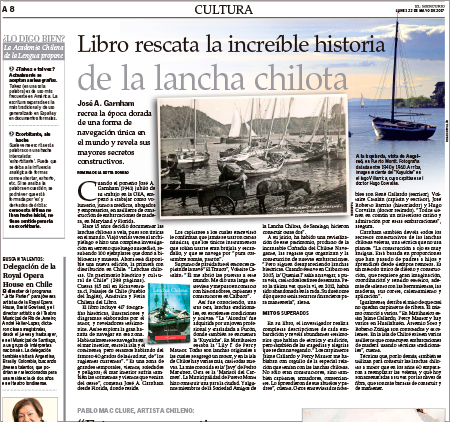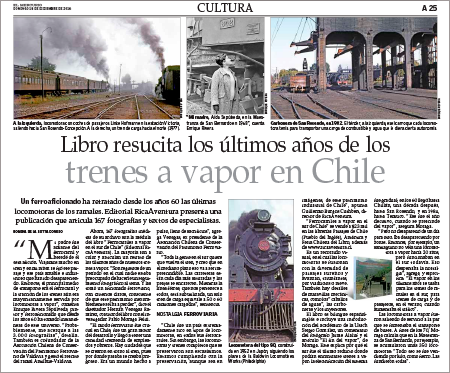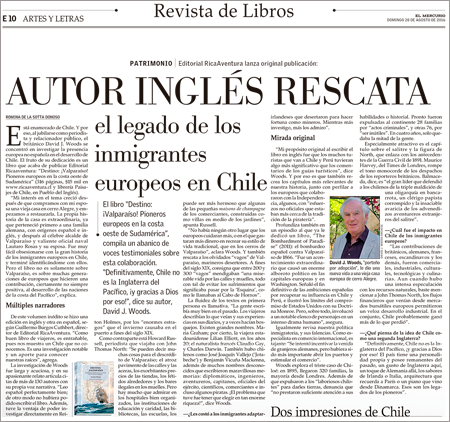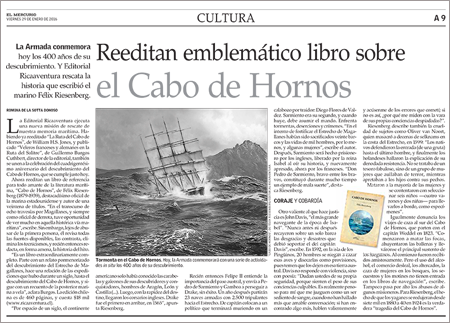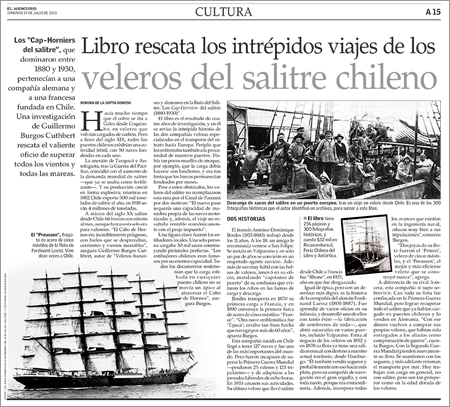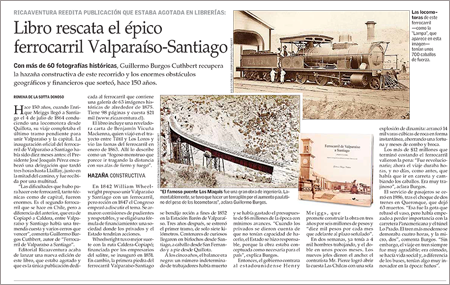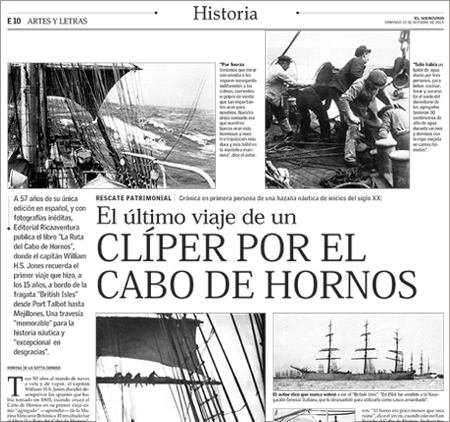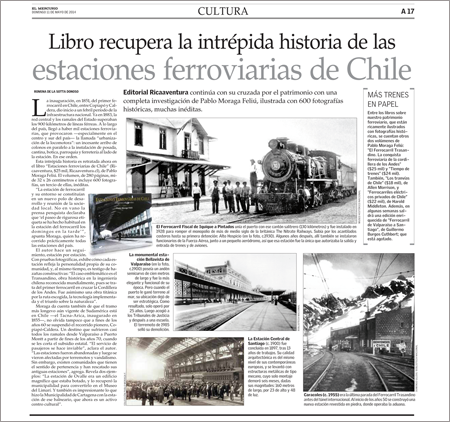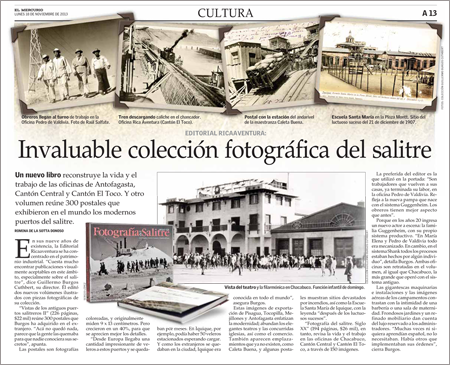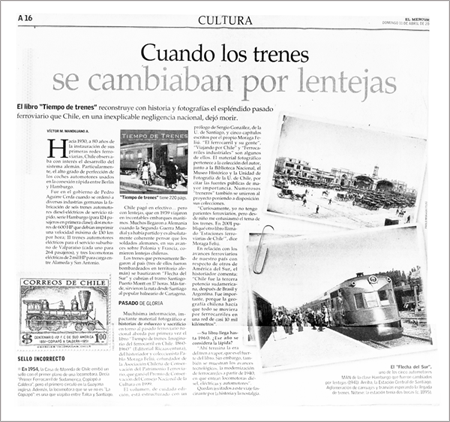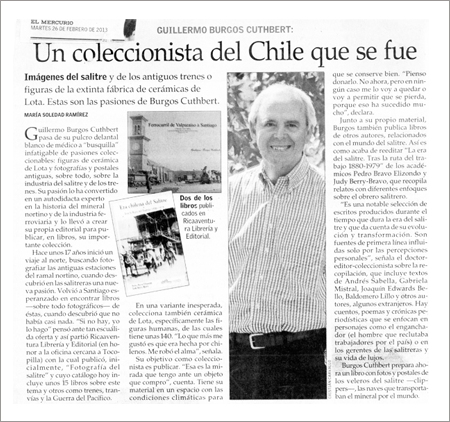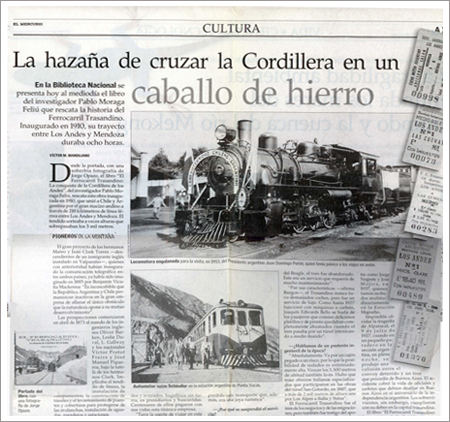ARTICLE OF THE DIARY EL MERCURIO :: DECEMBER 22th, 2018
"They rescue a centennial document that portrays the haciendas of Tierra del Fuego" (Extract of the article)
Editorial Ricaaventura retrieves a revealing document that is practically impossible to find: "Tierra del Fuego and the Magellanic channels", by Lieutenant Colonel Arturo Fuentes Rabé (1885-1945).
This is the complete report that the Army officer wrote about the trips he made a century ago to the southern tip of the country. The new edition has 412 pages and was enriched with 80 photographs of the time. "It is the first great book that is made about Tierra del Fuego, and one of the few that gives an account of the reality of the Estancias of the Exploiting Society of Tierra del Fuego (SETF). It is a brilliant story; Arturo Fuentes writes very well and has a very sharp eye. He does not believe everything they tell him, but he checks the data.
ARTICLE OF THE DIARY EL MERCURIO :: JULY 30th, 2018
"Rescue centennial publication that sought investors for saltpeter" (Extract of the article)
The project recovers a valuable historical document that it described a century ago to our north, the "high society" of Antofagasta and Iquique and the most successful merchants.
And now offers the second released of the collection: "Saltpeter region. Impressions of the Chilean Republic in the twentieth century "has 90 pages and 250 historical photographs. The volume costs $ 14 thousand (CLP), in www.ricaaventura.cl and Paisajes de Chile (Pueblo del Inglés), in addition to Antarctica Bookstore and Feria Chilena del Libro.
The edition is facsimile, so the unique tone used to highlight the thriving trade and the new fortunes that generated the nitrate is preserved.
The message, according to the editor, is "Hey, here is full of opportunities!".
ARTICLE OF THE DIARY EL MERCURIO :: APRIL 23th, 2018
"They publish true" bible "of Chilean railways" (Extract of the article)
The English specialist Wilfrid Simms made a complete cadastre of our trains in the trips of 1978 and 1987. Ricaaventura rescues this unique testimony, with more than 350 unpublished photographs.
A new volume dedicated to the national railway heritage launches Editorial Ricaaventura. Railroads of Chile. Visited in 1978 and 1987 ", by Wilfrid Simms, is a true illustrated" bible "of the trains that operate in our territory. Identify all the locomotives and their location, with more than 350 photographs that the English researcher himself took in the two trips he made to the country.
ARTICLE OF THE DIARY EL MERCURIO :: MAY 22th, 2017
"BOOK RECOVER THE INCREDIBLE HISTORY OF THE CHILOE BOAT" (Extract of the article)
José A. Garnham recreates the golden age of a form of navigation unique in the world and reveals its greatest constructive secrets.
When Buenos Aires native José A. Garnham (1941) retired from his job at the OAS, he began working as a volunteer, along with doctors, lawyers and businessmen, in shipbuilding yards of wooden boats in Maryland and Florida.
Fifteen years ago he decided to document the Chiloe boats with sail, because they are unique in the world. He traveled several times to the archipelago and did a thorough investigation in the field that he then self-published, resulting in 100 copies donated to libraries and museums. Now a new edition is available, the first with distribution in Chile: "Chiloe boats. A historical and cultural heritage of Chile ".
ARTICLE OF THE DIARY EL MERCURIO :: DECEMBER 18th, 2016
"BOOK RESURRECTS THE LAST YEARS OF STEAM TRAINS IN CHILE" (Extract of the article)
A ferroaficionado has been portraying the last locomotives of the branches since the 1960s. Editorial Ricaaventura presents a publication that articulates 167 photographs and texts of specialists.
"My father was a railroad lover and I inherited this hobby from him. We traveled a lot by train and in my childhood, that landscape and that kind and industrious country that have been disappearing was fixed. Then, the main means of transport was the railroad and the traction of the trains was still mostly served by steam locomotives, "says Enrique Rivera Sepúlveda, painter and ferroaficionado who since the 60s has taken snapshots of this universe. "Probably, I'm closer to the 3,000 photographs," he says.
ARTICLE OF THE DIARY EL MERCURIO :: AUGUST 28th, 2016
"ENGLISH AUTHOR RECOVER THE LEGACY OF EUROPEAN IMMIGRANTS IN CHILE" (Extract of the article)
He is in love with Chile. And so, when retiring as a journalist and public relations, the British David J. Woods concentrated on investigating the non-Spanish European presence in the development of Chile. The fruit of his dedication is a book that has just been published by Editorial Ricaaventura: "Destination: Valparaíso! European pioneers on the west coast of South America "
This unpublished volume was published in English and another in Spanish, according to Guillermo Burgos Cuthbert, editor of Editorial Ricaaventura. "As a good book of travelers, it is endearing, because it shows us a Chile that we do not know. It is a remarkable research and a contribution to know our roots, "he adds.
ARTICLE OF THE DIARY EL MERCURIO :: JANUARY 29th, 2016
"HAVE REISSUE EMBLEMATIC BOOK ABOUT THE CAPE HORN" (Extract of the article)
Editorial Ricaaventura executes a new rescue mission of our maritime memory. Having already reissued "The Cape Horn Route", by William H.S. Jones, and published "French and German sailboats on the Ruta del Salitre", by Guillermo Burgos Cuthbet, director of the editorial, also join the celebration of the four-hundredth anniversary of the discovery of Cape Horn, which is held just today.
Now they reissue a book of reference for every lover of maritime literature, "Cabo de Hornos", by Felix Riesenberg (1879-1939), an outstanding officer of the US Navy and author of some twenty titles.
"BOOK TELLS THE BOLD TRAVEL OF SAILBOATS OF THE CHILEAN SALITER" (Extract of the article)
It's been a long time since copper went to Wales from Coquimbo, in sailboats that returned loaded with coal. But at the end of the 19th century, all Chilean ports exhibited a feverish activity, with 50 ships anchored in each one.
The annexation of Tarapacá and Antofagasta, after the Pacific War, coincided with the increase in global demand for nitrate-which was already used as fertilizer. And its production grew explosively: while in 1882 Chile exports 500 thousand tons of saltpeter per year, in 1918 it will be 4 million tons.
At the beginning of the twentieth century, 66 boats with nitrate came out of Chile every month, although the crossing was only for the brave. "Cape Horn was incredibly dangerous, with falling ice, currents and unstable winds," says Guillermo Burgos Cuthbert, author of "French and German sailboats on the Ruta del Salitre. The Cap-Horniers of the saltpeter (1880-1930) ".
"BOOK RECOVER THE EPIC FERROCARRIL VALPARAÍSO-SANTIAGO" (Extract of the article)
150 years ago, when Enrique Meiggs arrived in Santiago on July 4, 1864 driving a locomotive from Quillota, his trip completed the last section pending for a Valparaiso and the capital. The official inauguration of the railroad from Valparaíso to Santiago had been ten months earlier: President José Joaquín Pérez headed a delegation that will take place in the last hours, until now, in the middle of the road.
"The difficulties that were made to make this railway, both the techniques and the capital, were enormous. It is the second railroad seen in Chile, but unlike the previous one, which was Copiapó to Caldera, between Valparaíso and Santiago, which was a tremendous hill and several hills to overcome, "comments Guillermo Burgos Cuthbert, author of" Ferrocarril de Valparaíso to Santiago ".
"THE LAST TRIP OF A CLIPPER FOR THE CAPE HORN" (Extract of the article)
After 50 years commanding ships with sail and steam, Captain William H.S. Jones decided to dust off the notes he had taken in 1905, when he crossed Cape Horn on his first trip as an "apprentice" - apprentice - of the British Merchant Marine. The result was the book "The Route of Cape Horn", where it specifies that "it was an exceptional trip in misfortunes and was cited as one of the most memorable of the last days of sailing."
The book was published in 1956 and the following year it was translated only once into Spanish. Now, Editorial Ricaaventura publishes it in Chile. "This trip is a true odyssey, which portrays both the daily life of seafarers of a century ago, as the crossing of Cape Horn, considered the most difficult in the world for the unpredictable and brutal climate," says Guillermo Burgos, director of the publisher. "In addition, this apprentice makes vivid memories of Chilean ports such as Iquique and Pisagua, and is witness to the Valparaíso earthquake of 1906," he adds. Of incalculable patrimonial value are the dozens of historical photographs that were added in the Chilean edition, part of the collection of Burgos.
"BOOK RECOVERS THE BOLD HISTORY OF THE CHILEAN RAILWAY STATIONS" (Extract of the article)
The inauguration, in 1851, of the first Chilean railway, between Copiapó and Caldera, began a feverish period of national infrastructure. Already in 1883, the central network and the branches of the State exceeded 900 kilometers of railway lines. Throughout the country, there were a thousand railway stations, which caused - especially in the center and south of the country - the so-called "urbanization of the locomotive": an incessant arrival of settlers in parallel to the installation of inn, canteen, apothecary , parish and hardware store next to the station. In that order.
"The railway station and its surroundings constituted a new pole of development and meeting of the local society. Not in vain did the Penquista press declare that 'the stroll of rigorous label has become common in the railway station on Sunday afternoons', "says Moraga, who has toured virtually every station in the country.
The author follows up, season by season. With photographic evidence, he shows how each station reflects the personality of his community, and, at the same time, witnesses constructive feats: "The emblematic case is Transandino, a historical work in Chilean engineering recognized worldwide, since it is the first railroad crossing the Andes mountain range. It was also a titanic work for the chosen route, the technology implemented and the triumph over nature ".
"INVALUABLE SALITRE PHOTOGRAPHIC COLLECTION"
(Extract of the article)
In its nine years of existence, Editorial Ricaaventura has concentrated on industrial heritage. "It costs a lot to find visually acceptable publications in this area, especially about nitrate," says Guillermo Burgos Cuthbert, its director. He edited two new volumes illustrated with photographic pieces from his collection.
"Views of the old nitrate ports II" gathers 300 postcards that Burgos has acquired abroad. "Nothing was left here, it seems that people burned them so that nobody knew their secrets," he says.
"Photograph of saltpeter. Twentieth century "meanwhile, review life and work in the offices of Chacabuco, Central Canton and Canton El Toco, through more than 150 images.
"WHEN THE TRAINS WERE CHANGED BY LENTILS"
(Extract of the article)
The book "Time of trains" reconstructs with history and photographs the splendid railway past that Chile, in an inexplicable national negligence, let die.
Around 1930, 80 years after the establishment of its first railway networks, Chile watched with interest the development of the German system. Particularly, the high degree of perfection of the automotive cars used in the fast connection between Berlin and Hamburg.
It was in the government of Pedro Aguirre Cerda when various German industries were ordered to manufacture six diesel-electric railcars, two 600HP engines, 11 electric railcars for the suburban service of Valparaíso and three electric locomotives of 2,000 HP for loading between Alameda and San Antonio.
Chile paid in cash ... but with lentils, which in 1939 traveled in countless sea shipments. Many arrived in Germany when the Second World War had already departed and it is absolutely coherent to think that the German soldiers, in their advances on Poland and France, ate Chilean lentils.
... A lot of information, impressive photographic material and stories of effort and sacrifice around the national railway past addresses for the first time the book "Tiempo de trenes. Imaginary of the railroad in Chile. 1860-1960 "(Editorial Ricaaventura) by the historian Pablo Moraga Feliú, co-founder of the Chilean Association for the Conservation of the Railway Heritage.
"A CHILEAN COLLECTOR THAT WENT"
(Extract of the article)
Images of the saltpeter and the old trains or figures of the extinct ceramic factory of Lota. These are the passions of Burgos Cuthbert.
... About 17 years ago he started a trip to the north, looking to photograph the old stations of the northern branch, when he discovered a new passion in the nitrate mines. He returned to Santiago, hoping to find books-especially photographic ones-of these, when he discovered that there was almost nothing. "If there is not, I'll do it" he thought before such a squalid offer and that is how Ricaaventura Librería y Editorial (in honor of the office near Tocopilla) started out, with which he initially published "Fotografía del Salitre" and whose catalog today includes about 15 books on this subject and others such as trains, trams and the Pacific War.
... Along with its own material, Burgos also publishes books by other authors, related to the world of saltpeter. This is how he has just reissued "La Era Chilena del salitre. After the route of work 1880-1979 "by academics Pedro Bravo Elizondo and Judy Berry-Bravo, which collects stories with different approaches to the nitrate worker.
"THE FEAT OF CROSSING THE CORDILLERA IN AN IRON HORSE"
(Extract of the article)
From the Cover with a superb photograph of Jorge Opazo, the book "The Trasandino Railroad: The Conquest of the Andes Mountains", by researcher Pablo Moraga Feliú, rescues this work inaugurated in 1910, which united Chile and Argentina for the great Andean massif through 218 Kilometers of railway line between Los Andes and Mendoza. The laying sometimes drew heights that exceeded 3 thousand meters.
The great project of the brothers Mateo and Juan Clark Torres - descendants of an English immigrant settled in Valparaíso - who had previously inaugurated the telegraphic communication between both countries, had already been imagined in 1885 by Benjamín Vicuña Mackenna: "It is inconceivable that the republic Argentina and Chile remain inactive in the great enterprise of paving the only obstacle that nature opposes to their mutual development ".
The explorations began in April 1873 under the command of the English engineers Oliver Bar-ken, Leslie Duval, L. Gallway and the nationalists Victor Pretot Freire and José Manuel Figueroa, under the tutelage of the Clark brothers. It involved the laying of lines, the installation of camps, the construction of tunnels and the lifting of bridges and sheds to protect themselves from avalanches, the installation of water points, stops and stations.
Construction in Chile began only in 1889, under the presidency of José Manuel Balmaceda, the workers who participated in it were seasoned and seasoned men. Tenants without land, former inmates and hustlers.

